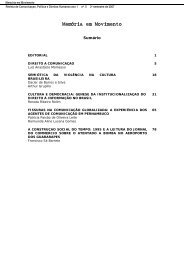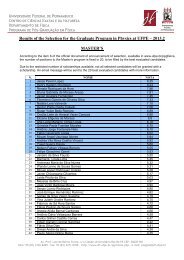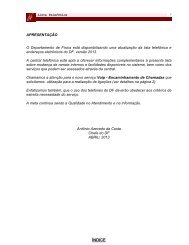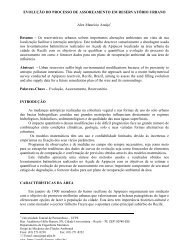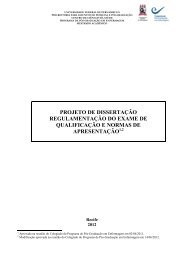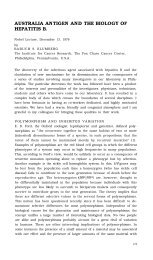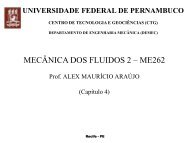View - ResearchGate
View - ResearchGate
View - ResearchGate
Create successful ePaper yourself
Turn your PDF publications into a flip-book with our unique Google optimized e-Paper software.
A.N. Sial et al. / Gondwana Research 13 (2008) 437–452<br />
447<br />
Fig. 6. (a) Mn/Sr vs. δ 18 O‰ PDB ratios for carbonates of the La Flecha and Silla Formations (data from Quebrada de la Flecha, Cerro La Silla and Quebrada de La<br />
Angostura). Almost all Mn/Sr ratios are below 0.2, an indication of near-primary isotope values; (b) δ 13 C vs. δ 18 O‰ PDB for carbonates of the La Flecha and Silla<br />
Formations (data from the three sections discussed in the text). Scatter rather, than co-variance, predominates.<br />
by Baldis et al. (1981, 1982) and Baldis and Bordonaro (1982),<br />
the La Flecha Formation was deposited in a shallow<br />
environment of low-energy conditions, with water of restricted<br />
circulation and periodic sub-aerial exposure, with only little or<br />
no terrigenous sediment input. Such environmental conditions<br />
would imply, in principle, that these carbonates should display<br />
some 13 C- and 18 O-enrichment, when compared with isotopic<br />
signatures of coeval marine carbonates.<br />
The δ 18 O values are slightly higher (mostly ∼−5‰ PDB),<br />
with few exceptions, than those observed in the La Silla<br />
Formation (∼−7to−8‰ PDB; Fig. 8). Such a situation indicates<br />
that most δ 18 O values are primary and implies that environments<br />
in which these two formations were deposited differed from each<br />
other, the La Flecha Formation environment being more<br />
restricted, of hypersaline tendency, approaching a sabkha.<br />
There is always a potential for isotopic alteration during<br />
dolomitization (Sheppard and Shwarcz, 1970) but apparently, in<br />
the uppermost portion of this section, dolomitic limestones do<br />
not show a substantial change in Mn/Sr ratios in relation to the<br />
underlying marly limestones as shown in Fig. 8. All δ 13 C values<br />
obtained in the entire section in the present study are negative,<br />
except for 8 points (very close to 0‰ PDB). In this δ 13 C<br />
stratigraphic profile, two excursions seem to be of stratigraphic<br />
importance (labelled I and II in Fig. 8). The upper boundary of<br />
the La Flecha Formation is dolomite-dominated and the<br />
transition to the La Silla Formation is marked by the presence<br />
of black shales and Thallasinoids. A discrete positive,<br />
asymmetric excursion (labelled I), recorded in dolomites, is<br />
interpreted as corresponding to SPICE. It is, however, less<br />
developed, because of dolomite deposition from water of<br />
restricted circulation. The negative excursion labelled II, in the<br />
La Silla Formation, is probably equivalent to SNICE, recorded<br />
in limestones deposited in open sea.<br />
3.3.1.3. Quebrada de La Angostura. A total of 31 samples<br />
were analyzed from the Quebrada de La Angostura and δ 18 Ois<br />
mostly between −8 and −9‰ (Fig. 9) with stronger fluctuation<br />
towards the top of the La Flecha Formation. Some of the δ 18 O<br />
values reach values as low as −13‰ and are regarded here as<br />
altered. As expected, δ 13 C ratios exhibit a more consistent<br />
behavior and display negative values up to half way of the<br />
chemostratigraphic profile and up-section these ratios become<br />
positive, reaching values as high as +5.6‰ at the level that is<br />
composed of transgressive black shale and intercalated marly<br />
limestone. Unfortunately, thrust faults have precluded us from<br />
sampling stratigraphically up-section.<br />
We interpret this positive excursion as a record of SPICE<br />
which implies a deposition of the uppermost La Flecha<br />
Formation, in this section, during the Steptoean stage. This<br />
situation implies that the La Flecha Formation in the northern<br />
Central Precordillera was deposited synchronously with the<br />
deposition of the Zonda Formation in the eastern Precordillera<br />
(San Juan sub-basin) at the Quebrada de La Flecha during the<br />
Steptoean and confirms the assumption made by Keller (1999)<br />
concerning the diachronous character of these units.<br />
3.3.2. Sr-isotope stratigraphy<br />
At Quebrada de La Flecha, 87 Sr/ 86 Sr ratios for the Zonda<br />
Formation carbonates vary from 0.70924 to 0.70955, and for the<br />
La Flecha Formation from 0.70908 to 0.70942. At Cerro La Silla,<br />
this ratio varies, for the La Flecha Formation, from 0.70914 to<br />
0.70923, with only one exception (0.71011), at the transition to



